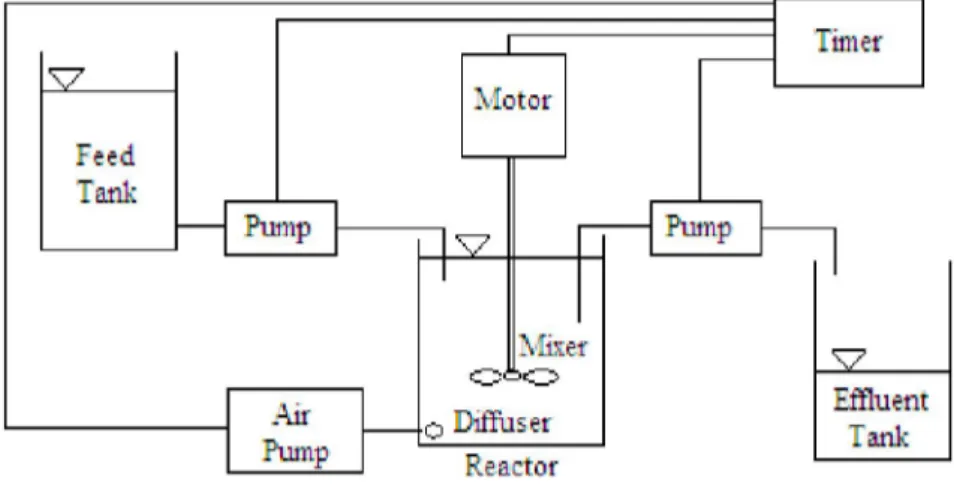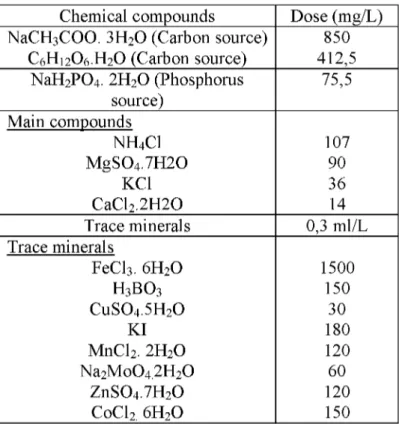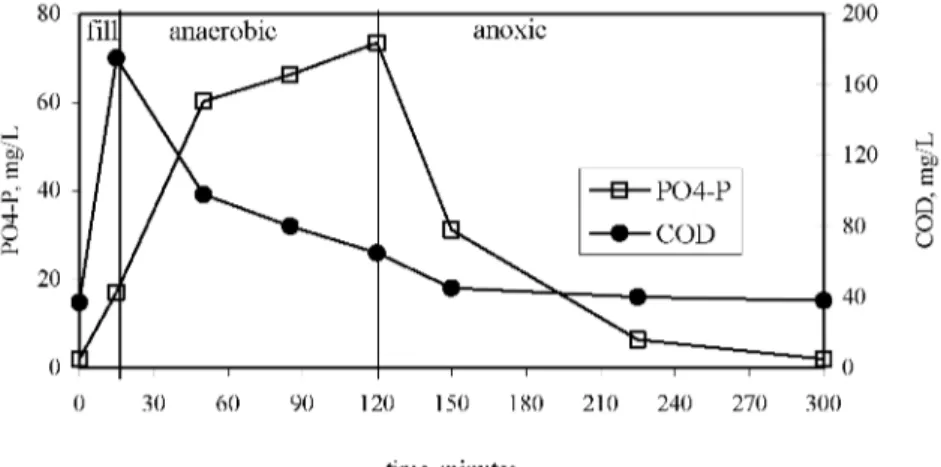©BEYKENT UNIVERSITY
THE DENITRIFYING BIOLOGICAL PHOSPHORUS REMOVAL PERFORMANCE IN ANAEROBIC/ANOXIC
SEQUENCING BATCH REACTOR: THE EFFECT OF CARBON SOURCE*
Engin GÜRTEKİN, Nusret ŞEKERDAĞ
Department of Environmental Engineering, Fırat University, 23119 Elazığ, Turkey, E-mail: egurtekin@firat.edu.tr
ABSTRACT
In this study, the effect of carbon source on denitrifying biological phosphorus removal performance in acetate and glucose fed two anaerobic/anoxic sequencinq batch reactor (SBR) was investigated. Glucose and acetate were used as the substrates. In acetate and glucose fed reactors, the COD (Chemical Oxygen Demand) removal efficiencies were 91,90% and PO4-P removal efficiencies were 87,51% respectively. These results shows that the phosphorus removal efficiency is lower in glucose fed reactor.
Keywords: Biological phosphorus removal, anaerobic/anoxic, carbon source, acetate, glucose.
ÖZET
Bu çalışmada, asetat ve glikozla beslenen iki ayrı anaerobik/anoksik ardışık kesikli reaktörde (AKR) denitrifikasyonla biyolojik fosfor giderim işlemine karbon kaynağının etkileri araştırılmıştır. Besi maddesi olarak glikoz ve asetat kullanılmıştır. Asetat ve glikozla beslenen reaktörlerde KOİ (Kimyasal Oksijen İhtiyacı) giderme verimleri sırasıyla % 91,90 ve fosfat giderme verimleri % 87,51'dir. Bu sonuçlar, glikozla beslenen reaktörde fosfor giderme veriminin daha az olduğunu göstermektedir.
Anahtar Kelimeler: Biyolojik fosfor giderimi, anaerobik/anoksik, karbon kaynağı,
asetat, glikoz.
1. INTRODUCTION
* This study was supported by the Scientific Researchs Projects of Firat University (FÜBAP) under Project No. 926.
The cycling anaerobic-aerobic phases and short chain fatty acids (SCFAs) are two necessary factors for the conventional biological phosphorus removal based on the activity of polyphosphate accumulating organisms (PAOs). In anaerobic phase, PAOs store organic substrate in the form of polyhydroxyalkoanates (PHA). The energy required for PHA strorage is provided by hydrolysis of the internally stored polyphosphate to phosphate. Simultaneously, the glycogen content of cells decreases to maintain the redox balance in the cells. In aerobic phase, PAO use the stored PHA for growth and replenishment of glycogen and phosphorus uptake [1].
In last years, an anaerobic-anoxic processes based on the activity of denitrifying polyphosphate accumulating organisms (DPAOs), which one fraction of PAOs have been proposed [2,3,4,5]. DPAOs use nitrate as electron acceptor instead of oxygen. The stoichiometric and kinetic properties of DPAOs are similar to PAOs [6]. The advantages of using nitrate are the saving of organic substrate, energy and the reducing of sludge production.
Acetate is the most favourable short chain fatty acid for conventional biological phosphorus removal. However, there are contradictory informations connected to effect of glucose on conventional biological phosphorus removal. Some researches observed that biological phosphorus removal by glucose was deteriorated [7,8]. Some researchers also observed that biological phosphorus removal by glucose was realised [9,10,11].
Liu et al. [11] suggested that molecular oxygen was an absolute requirement for the synthesis of sludge carbonhydrate (CH). Wang et al. [12] also found that shorter aerobic reaction time with lower DO level was essential to maintain the stability of the biological phosphorus removal process in glucose fed reactor. The objective of this study was to examine the effect of carbon source on denitrifying phosphorus removal performance. Therefore, the anaerobic-anoxic process without an aerobic phase
was used in this study and the biological phosphorus removal performances were investigated in acetate and glucose fed anaerobic/anoxic SBRs.
2. MATERIALS AND METHODS 2.1 Sequencing Batch Reactor
This study was performed in 2 L two lab-scale anaerobic/anoxic sequencing batch reactor (Fig. 1). The reactors were operated 20±2°C in a thermostatic room. The cycle time of both reactors was 6 hours. A cycle consisted of: filling (15 min), anaerobic (105 min), anoxic (180 min), settling (30 min), decanting (15 min), idle (15 min). Both reactor were fed with 0.9 L synthetic wastewater during filling phase. 0.1 L nitrate solution (60 mmol/l) was fed to the reactors during the first 120 minutes of the anoxic phase. In decanting phase, 1.0 L supernatant was discharged. The hydraulic retention time was 12 hours. The sludge retention time was maintained at 10 days in both reactors through the removal of 200 mL of mixed liquor per day at the end of the anoxic phase. N2 gas was continuously flowed through the reactor head space to prevent introduction of oxygen in both reactor. The pH was not controlled in both reactors.
2.2. Synthetic Wastewater and Seeding Sludge
The reactors were fed with the same synthetic wastewater composition except for carbon source (Table 1). As carbon source, one of reactors was fed with acetate, the other was fed with glucose. Seeding sludge was taken from a municipal treatment plant designed for nitrogen and phosphorus removal.
The COD, phosphorus and phosphorus percent in sludge were measured by Standard Methods [13]. MLSS and MLVSS concentrations were determineted using Whatman GF/C filter. The ammonium and nitrate was measured by Standard Kit (Merck Specquorant).
3. RESULTS AND DISCUSSION
The COD, NH4-N and PO4-P concentrations of synthetic waste
water fed to the reactors were 400, 28 and 15 mg/L in throughout
Figure 1. The schematic diagram of SBR
study. In acetate and glucose fed reactors, the MLSS concentrations changed between 2050-2150 mg/L and 2070-2150 mg/L, respectively. MLVSS concentrations changed between
1360-1430 mg/L and 1630-1730 mg/L, respectively. The ratio of MLVSS to MLSS changed between 0.654-0.684 and 0.796-0.808, respectively. The phosphorus percent of sludge in the end of the anoxic phase changed between 12-12.2 and 7-7.2, respectively.
The carbon uptake and phosphorus release were observed in the anaerobic phase (Fig. 2 and 3). The carbon uptake was the same for both reactor. In acetate and glucose fed reactors, the phosphorus concentrations in the end of anaerobic phase changed between 70.58-74.40 mg/L and 45.80-48.10 mg/L, respectively. This shows that the phosphorus release is lower in glucose fed reactor. This was likely correlated to reduced anaerobic accumulation of PHA as reported by Wang et al. [14].
Table 1. Synthetic Wastewater Composition
Chemical compounds Dose (mg/L)
NaCH3COO. 3H2O (Carbon source) 850
C6H12O6.H2O (Carbon source) 412,5
NH2PO4. 2H2O (Phosphorus 75,5
source) Main compounds NH4Q 107 MgSO4.7H2O 90 KCl 36 CaCl2.2H2O 14 Trace minerals 0,3 ml/L Trace minerals FeCl3. 6H2O 1500 H3BO3 150 CuSO4.5H2O 30 KI 180 MnCl2. 2H2O 120 Na2MoO4.2H2O 60 ZnSO4.7H2O 120 CoCl2. 6H2O 150
The anoxic phase was initiated by the addition of nitrate. The nitrate added to the anoxic phase was almost exhausted and the nitrate concentration entering to the anaerobic phase was
lower than 1 mg/L. Therefore, the effect of nitrate on the phosphorus release in anaerobic phase was unimportant in this study. Barker and Dold et al. [15] reported that the entering of nitrate to the anaerobic phase was detrimental to the phosphorus removal.
time, minutes
Figure 2. The COD and PO4-P profiles in acetate-fed reactor.
In acetate and glucose fed reactors, the effluent COD concentrations changed between 32-40 mg/L and 40-46 mg/L corresponding to approximately 91 % and 90 % removal, respectively. However, the COD concentrations in the end of anaerobic phase changed between 65-85 mg/L and 60-72 mg/L, respectively. Ng et al. [16] obtained that the residual carbon in the anoxic phase could cause a reduction of phosphorus uptake due to the competition for nitrate by denitrification attributed by non poly-p denitrifers. But, the phosphorus uptake in the anoxic phase of both reactor occured in this study. Astgaard et al. [17] found that if sufficient nitrate was present there was noticeable phosphorus uptake rather than phosphorus release. You et al [18]
also obtained that electron acceptor was significant influence on the phosphate uptake/release characteristics, while the residual COD concentrations have little influence on that. The results of this study show that the nitrate amount in anoxic phase is more important than the residual COD concentrations.
time, minutes
Figure 3. The COD and PO4-P profiles in glucose-fed reactor.
The synthetic wastewater fed to the reactors had low COD/P ratio. The phosphorus release occured in the anaerobic phase of both reactor. This shows that DPAOs are dominant. Suidiana et al. [19] and Whang et al. [20] observed the phosphorus release in the glucose fed reactor when the synthetic wastewater had low COD/P ratio. Liu et al. [21] also inhibited the growth of poly-p bacteria with high COD/P ratio. This indicates that the biological phosphorus removal is obtained in glucose fed reactor when suitable glucose/P ratio is supplied.
The pH control wasn't made in the reactors. The pH value in the anaerobic phase decreased. But, its value didn't fall below of 7. Because, the pH value at the end of anoxic phase changed
between 7.5-8. Wang et al. [14] observed that pH value in the anaerobic phase of glucose fed reactor dropped to between 5 and 6 from an initial value of 7. The high pH value in the anaerobic phase is an important factor for the high phosphorus release. Because, the more energy is needed for carbon uptake in the anaerobic phase as reported by Smolders et al. [22].
In acetate and glucose fed reactors, the effluent phosphorus concentrations changed between 1.90-2.50 mg/L and 7.10-7.44 mg/L corresponding to approximately 87 % and 51 % removal, respectively. The low phosphorus removal efficiency can be due to the nitrate use by electron acceptor and the residual COD concentrations entering to the anoxic phase. In glucose fed reactor, it can be also given the glucose use by substrate in addition to this factors.
If the nitrate added in the anoxic phase is obtained with nitrification, this process can be applied at full-scale wastewater treatment processes. For this, an aerobic phase is needed. This can be achieved in a single or two sludge system as reported by Kuba et al. [23].
4. CONCLUSIONS
The carbon uptake in the anaerobic phase was the same for both reactors. But, the phosphorus release was lower in glucose fed reactor. The phosphorus uptake in the anoxic phase of both reactors was obtained in spite of the residual COD concentrations. Because, the amount of nitrate that serve as an electron acceptor for phosphorus uptake in the anoxic phase was sufficient. In acetate and glucose fed reactor, the biological phosphorus removal was obtained. However, the phosphorus removal efficiency was lower in glucose fed reactor. It was found that biological phosphorus removal is obtained in glucose fed reactor when suitable glucose/P ratio is supplied.
REFERENCES
[1] Mino, T., van Loosdrecht, M.C.M. and Heijnen, J.J. Microbiology and biochemistry of the enhanced biological phosphate removal process. Water Research, 32 (11), (1998), 3193-3207.
[2] Vlekke, G.J.F., Comeu, Y. and Oldham, W.K. Biological phosphate removal from wastewater with oxygen or nitrate in sequencing batch reactors. Environmental Technology Letters. 9, (1988), 791-796.
[3] Wanner, J., Cech, J.S. and Kos, M. New Process Design for Biological Nutrient Removal, Water Science and Technology, 25, (4-5), (1992), 445-448.
[4] Kuba, T., Smolders, G.J.F., van Loosdrecht, M.C.M. and Heijnen, J.J. Biological phosphorus removal from wastewater by anaerobic anoxic sequencing batch reactor. Water Science and Technology, 27, (1993), 241-252.
[5] Kern-Jespersen, J.P. and Henze, M. Biological phosphorus uptake under anoxic and aerobic conditions. Water Research, 27, (1993), 617-624.
[6] Kuba, T., van Loosdrecht, M.C.M. and Heijnen, J.J. A metabolic model for biological phosphorus removal by denitrifying organisms. Biotechnology and Bioengineering, 52, (1996), 685-695.
[7] Cech, J.S. and Hartman, P. Glucose induced breakdown of enhanced biological phosphate removal. Environmental Technology, 11, (1990), 651-656.
[8] Satoh, H., Mino, T. and Matsuo, T. Deterioration of enhanced biological phosphorus by the domination of micro-organisms without polyphosphate accumulation. Water Science and Technology, 30 (6), (1994), 203-211.
[9] Nakamura, K., Masuda, K. and Mikami, E. Isolation of a new type of polyphosphate accumulating bacteria and its phosphate removal characteristics. Journal Fermentation Bioengineering, 71, (1991), 258-263
[10] Carucci, A., Lindrea, K., Majone, M. and Ramadori, R. Dynamics of the anaerobic utilization of organic substrates in an anaerobic/aerobic sequencing batch reactor. Water Science and Technology, 31 (2), (1995), 35-43.
[11] Liu, Y.H. Relation between sludge carbonhydrate content and biological phosphate removal, Water Research, 32 (5), (1998), 1635-1641.
[12] Wang, N., Peng, J. and Hill G. Biochemical model of glucose induced enhanced biological phosphorus removal under anaerobic condition. Water Research, 36, (2002), 49-58. [13] APHA. Standart Methods for the Examination of Water and Wastewater, 17th Edition, American Public Health Association, Washington, D.C., (1989).
[14] Wang, N., Hill, G. and Peng, J. The Role of glucose in developing enhanced biological phosphorus removal. Environmental Engineering Policy, 3, (2002), 45-54.
[15] Barker, P.S. and Dold, P.L. Denitrification behaviour in biological excess phosphorus removal activated sludge systems. Water Research, 30, (1996), 769-780.
[16] Ng, W.J., Ong, S.L. and Hu, JY. Denitrifying phosphorus removal by anaerobic/anoxic sequencing batch reactor. Water Science and Technology, 43, (2001), 139-146.
[17] Astgaard, K., Christensson, M., Lie, E., Jonsson, K. and Welander, T. Anoxic biological phosphorus removal on a full-scale UCT process. Water Research, 31, (1997), 2719-2726.
[18] You, S.J., Shen, Y.J., Ouyang, C.F. and Hsu, C.L. The effect of residual chemical oxygen demand on anoxic and aerobic
phosphate uptake and release with various intracellular polymer levels. Water Environment Research, 76, (2004),
149-154.
[19] Sudiana, I.M., Mino, T., Satoh, H., Nakamura, K. and Matsuo, T. Metabolism of enhanced biological phosphorus removal and non-enhanced biological phosphorus removal sludge with acetate and glucose as carbon source. Water Science and Technology, 39, (1999), 29-35.
[20] Whang, J.C., Park, J.K. and Whang, L.M. Comparison of fatty acid composition and kinetics of phosphorus-accumulating organisms and glycogen-phosphorus-accumulating organisms. Water Environment Research, 76, (2001), 704-710.
[21] Liu, W.T., Mino, T., Nakamura, K. and Matsuo, T. Glycogen accumulating population and its anaerobic substrate in anaerobic-aerobic activated sludge without biological phosphorus removal. Water Research, 30, (1996), 75-82.
[22] Smolders, G.J.F., van der Meij, J., van Loosdrecht, M.C.M. and Heijnen, J.J. Model of the anaerobic metabolism of the biological phosphorus removal process: stoichiometry and pH influence. Biotechnology and Bioenginering, 43, (1994), 461-470.
[23] Kuba, T., van Loosdrecht, M.C.M. and Heijnen, J.J. Biological dephosphatation by activated sludge under denitrifying conditions: pH influence and occurence of a full-scale wastewater treatment plant. Water Science and Technology, 36,(1997),75-82.



